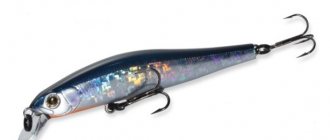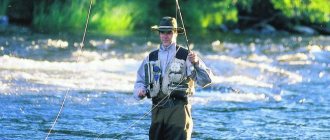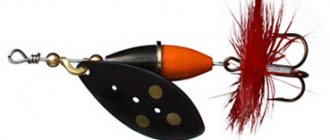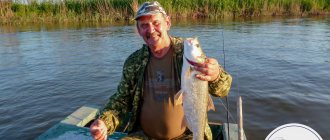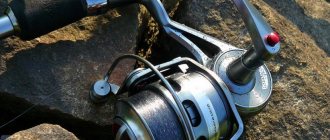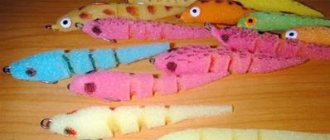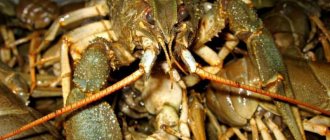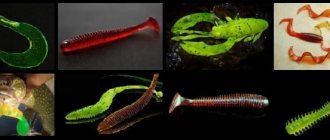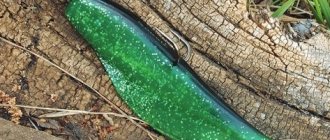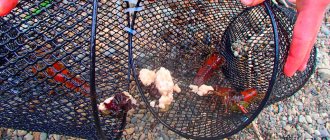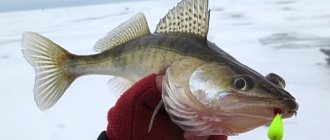The lion's share of the product range of each store specialized in fishing is occupied by fishing lures for spinning fishing. The diversity of the product allows us to expand the possibilities of catching not only predatory fish, but also some species of peaceful fish from the carp family. Every day the range of artificial baits grows with new spinning baits, sometimes the principle of operation of which is not always initially clear even to virtuosos of using spinning tackle, not to mention a beginner.
The ability to identify a promising simulator is an integral part of the experience of a spinning fisherman. A competent selection of a fishing candidate will bring in trophies not only pike, pike perch and perch, which are popular in spinning fishing, but can also give real chances in the hunt, the target of which will be burbot and catfish, as well as rudd and even crucian carp. The following useful information article will help the angler understand in more detail the specifics of spinning fishing tools.
Spoon
The classic, oldest and most well-known tool for spinning fishing is the spinner. Over the course of a couple of hundred years, these spinning lures have been transformed from primitive pieces of reflective metal into complex structures that lure the trophy not only with a reflection that imitates reflections from the scales of the prey, but also with vibration and sound waves affecting the sense of touch of a predatory fish. Fishermen often use homemade baits for spinning rods, which are made from scrap materials by bending tin spoons and adapting tablespoons familiar to the average person for this purpose.
Most types of spoons work effectively on almost all types of fish and are inexpensive. They differ from each other not only in shape and principle of operation, but also in standard sizes and weight, which gives anglers a real chance to select the right fishing tool for the prevailing fishing conditions. There are two main types of baits, which we will continue our conversation about.
Spinners
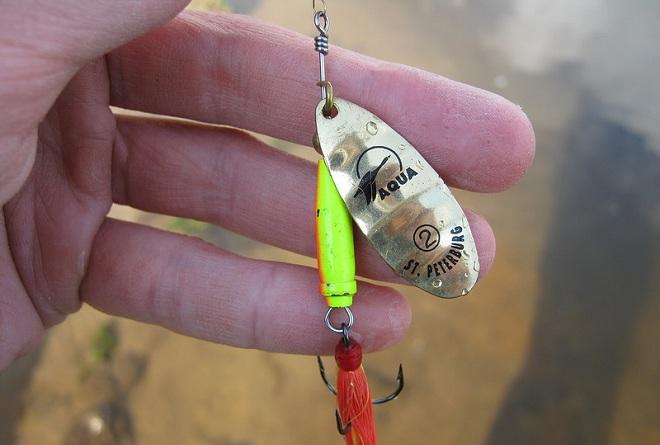
The design of the rotating spoon is designed in such a way that when retrieved, the petal strung on a metal rod makes circular movements around it, creating strong vibrations and a peculiar sound that arouses the interest of the fish. The color of the rotating petal determines the visual perception of the simulator by the fish, and the use of one or another color of the pinwheel depends on the intensity of the lighting.
The object of hunting with this tool is perch, pike and often trophy rudd and ide. Pinwheels are usually classified according to the size of the petal and its shape, as well as by weight. The purpose of the spinner is to fish shallow areas of a reservoir with a spinning rod, usually no more than three meters, in moderate and weak currents at various hunting distances.
Spoons
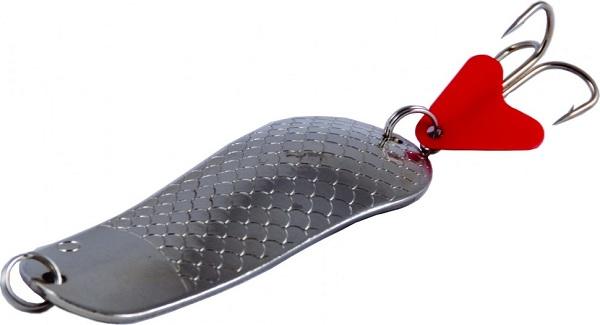
The spoon is the most common type of spoon. As a result of the wiring performed during hunting, the presented tool, the working body of which is a metal plate curved at various angles, makes smooth, sweeping oscillatory movements. In the classics, the oscillating spoon represents the scoop of an ordinary tablespoon, differing from each other in the mass and size of the plate, as well as the spectrum of its color.
The main object of hunting for spinners is considered to be pike, although anglers specifically fish with such spinners for asp, perch, trout and catfish. Nowadays, there are many varieties of oscillators with special specificity of application and striking visual differences from the prototype. We will consider some of these modifications of oscillators that are most popular in use in more detail.
Castmaster
Castmaster spinners have the form of a cylindrical solid piece of metal, on both edges of which an oblique cut is made. The cut can be made at different angles, which will determine the characteristics of the spinner's game. The main difference between castmasters is the distinct edges that form sharp angles with the base.
Important! Castmasters have high ballistic properties, characterized by increased range and sharpness of play. Tool options differ not only in cut angles, but also in mass.
The castmaster is suitable for fishing both in shallow waters and for fishing in deep holes. Often the color of the bait, and in the classics of the genre it is silver or gold, is complemented with a holographic sticker or fluorescent coating. The object of fishing is deep-sea predators: pike perch, burbot and catfish.
Cicada
The cicada consists of a single piece of metal plate, cut to resemble the body of a fish. The plate has a number of through holes, the area of location and diameters of which characterize the main parameters of the simulator's game. As a rule, cicadas are quite weighty spoons and their weight is rarely below 12 grams. Due to its weight, the spinner is distinguished by high flight qualities and stability of play. The design of the vibrator may contain two treble hooks.
The wiring of the cicada is accompanied by noise effects and distinct vibration. All types and types of cicada baits are a universal tool that works both as a spinning horizontal spoon and as an under-ice version of the spoon for vertical fishing. Specializes in fishing for pike, pike perch and pike perch.
Devons
Devon is one of the unusual baits, the design of which is an elongated body in the form of a base equipped with a turbine or screw. When wiring, the screw rotates due to the resulting resistance of the water and creates noise effects and vibration waves spreading far in the water column. The Devonian body itself can have a faceted or cylindrical shape and be painted in different colors. Some types of spinners are equipped with two multi-directional turbines. Devons are equipped with one treble hook at the end of its body.
Due to its design features, the spinner is material-intensive, which is reflected in the high mass of the simulator, but this gives the product long-range quality and stability when retrieving. Devons are mainly used on fast retrieves, hunting for active and sharp fish. In particular, asps are responsive to the game of the Devon, but large perch and pike of various sizes are expected in the catches.
Lures made of silicone and edible rubber
Soft lures made of silicone - henceforth simply lures - have literally revolutionized the fishing world of spinners, deservedly gaining popularity among them due to their many advantages. With the advent of silicone baits, spinning fishermen gradually began to forget about homemade foam rubber fish, popular in Soviet times, which are less and less used by amateur fishermen nowadays.
The variety of colors of artificial silicone baits made it possible to use them at any time of the day and in any weather. Not only predatory fish, but also peaceful inhabitants of reservoirs are seduced by their tempting color and appearance. Even peaceful fish such as silver carp and rudd bite well on silicone twisters and vibrotails. This bait is used in various fishing methods. Miniature silicone artificial baits are used to catch peaceful fish; in a plumb line, on bottom gear, as well as in the usual float method.
So what is silicone bait and how is it different from edible rubber? Silicone baits, like edible rubber baits, are made from the same material - silicone, with the only slight difference that special flavors - attractants, flavoring additives and salt are added to edible rubber. Essentially the same bait only with a taste.
Some Chinese manufacturers, reducing production costs, use a cheap substitute - PVC - instead of high-quality silicone. PVC baits are harder and less elastic, which significantly reduces their catchability.
Artificial baits made of silicone are imitation fish, crustaceans, frogs and other inhabitants of the reservoir that make up the main food supply of predatory fish. They are equipped with offset hooks, tees and doubles, as well as special jig heads, which are a monolithic hook structure with a sinker located at its base.
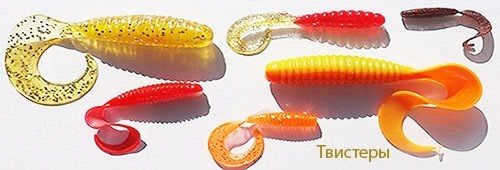
In the process of retrieving, the silicone bait makes wave-like movements generated by the fisherman, rising to the surface and falling to the bottom. The frequency and amplitude of which depends on the wiring technique, and the speed of immersion depends on the weight of the jig head and can be supplemented with jerks - twitch . Such wiring with jerks is called “twitching” and “jigging” . It is important that the bait does not sink to the bottom very quickly; for this, the jig head should not exceed the required weight.
Jig heads, eared sinkers and hooks
The main advantages of soft bait are its low price and, at the same time, excellent catchability, ensured by the fact that predatory fish make several attacks on soft bait in one retrieve.
A soft, jelly-like bait with a hardness not much different from the food object does not alarm the fish during the first, unsuccessful or test bite, and the predator continues to attack it again, thereby giving the fisherman an additional chance to catch it. While a hard-tasting bait scares away the fish after the first unsuccessful bite.
The next significant advantage of a soft bait is its ability to pass without snags in the bottom layer of water overgrown with grass - where any other bait can; a wobbler, a spinner or a spinner will remain forever. This is achieved by the possibility of special installation of an offset hook into the soft body of the bait, so that the tip of the hook is maximally protected from snags.
Silicone baits are divided into active - having a moving element that attracts the attention of fish, and inactive - sedentary, not having independently moving body parts that can provoke a predator to attack .
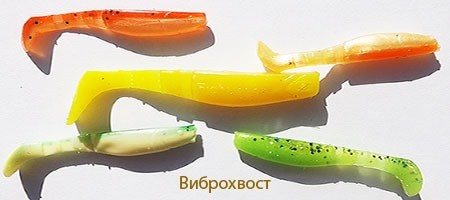
Lures with jig heads
The most common active silicone baits include twisters and vibrotails. The tail part of these baits vibrates during movement, creating acoustic vibrations in the aquatic environment that strongly attract fish. This quality, complemented by different colors and flavors, if you take edible rubber, attracts predatory fish, and the correct animation of the bait provokes it to attack.
All other baits: worms, newts, frogs, squids, crustaceans, etc. refer to inactive baits, which, in order to closely resemble the behavior of a natural food object, require certain manipulations carried out over them with a rod and reel, using special wiring techniques.
The size of silicone baits is determined in inches - the minimum is 1 inch - 2.54 cm and is indicated on the packaging, the weight of the jig head is calculated in grams, often marked on the jig head itself.
The actions outlined in the article should not be taken as an axiom that does not require proof. You have to try everything yourself and conduct experiments, thanks to which new equipment and fishing accessories are born. Ingenuity is the engine of progress!
Best wishes! See you again!
Silicone baits
Thanks to the advent of such a material as silicone, spinning fishermen have received in their arsenals a wide family of simulators that are believable in movement, varied in shape and color. Even a novice spinning player is familiar with such types of silicones as twisters and vibrotails. The differences between these nozzles are in the shape of their working bodies, or rather, tails. The vibrotail has a short tail on a thin leg in the shape of a horse's hoof, for which such instruments are often called hooves. Twister, on the other hand, has a sickle-shaped tail similar to a ribbon and its size can exceed the body length by 1.5-2 times.
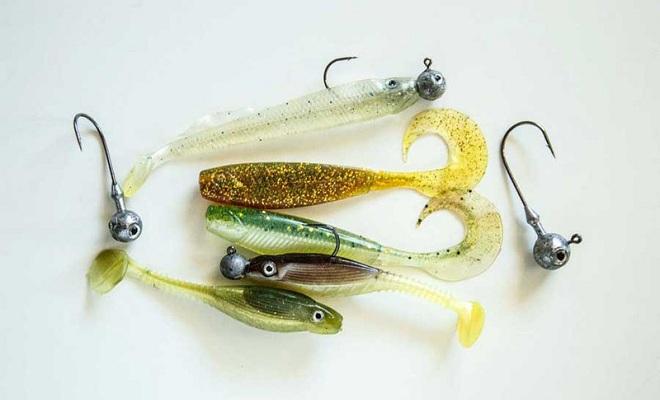
Both the vibrotail and the twister, when retrieved, imitate the behavior of the fry, creating movements in the water that are attractive to the predator. In addition to the vibrotail and twister, slugs, silicone in the form of worms, and other fantasy forms that resemble both real underwater inhabitants, beetles, crustaceans and insect larvae, and fictional entities are used for fishing. Silicone is divided into two types according to its composition - regular and edible. The differences between the species are that the edible type contains strong-smelling attractants in the material, which additionally attract fish to the location.
Silicones are varied in color, size and direction of smell, but when used they require shipping and are not durable and durable. But in terms of cost, silicone is quite affordable. Spinning anglers use silicone rods to catch both predators and peaceful fish. For example, perch, pike and pike perch are caught using vibrating tails and twisters on jigs and spaced types of rigs, and using certain techniques of fishing with slugs in the form of a worm, it is quite possible to fish for crucian carp, carp and bream.
The best wobblers for spinning
ZipBaits ORBIT 110 SP, 11 cm, 16.5 g
Rating: 5.0
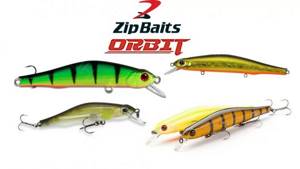
Another representative of the minnow class, which has proven itself to be an experienced “fighter” with trophy fish in reservoirs of any type. With a length of 110 millimeters, its weight was 16.5 grams, which largely determined the use of the wobbler as a tackle for long-distance casting. But without the implementation of the ideas of the ZipBaits engineers, the flight qualities of the bait could cause big problems. The elongated shape of the minnow with a stationary load had windage - it was literally carried away from the intended place of fall. But thanks to the system of a floating magnetic sinker, which by inertia moves to the tail, the casting accuracy was significantly increased.
As for the cost of ZipBaits ORBIT 110 SP, not every angler can afford it. This wobbler was created as a full-fledged professional bait, for which it was awarded an exorbitant price tag.
Advantages
- well-thought-out cargo system;
- good flight characteristics;
- a huge assortment of fish of various colors;
- Focused on fishing for trophy pike and pike perch.
Flaws
- high price.
ZipBaits Khamsin 70 SP
Rating: 4.9
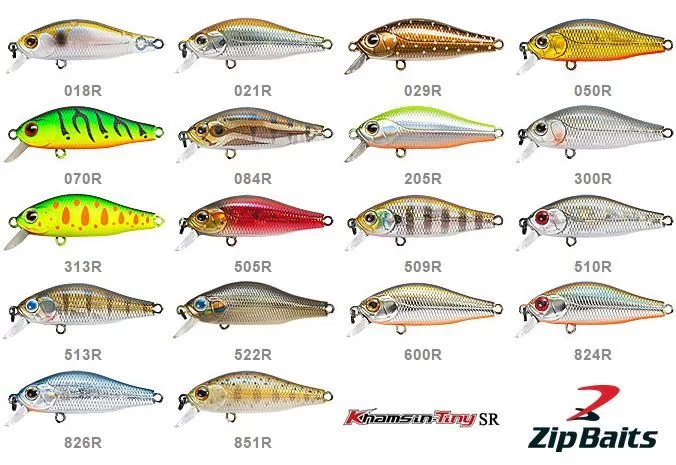
The first and only shad included in the overall rating of the best wobblers for spinning. It performs excellently when fishing in shallow depths, mainly in freshwater reservoirs. No less efficiently “cleans” overgrown water, which is rich in predators such as large and lazy pike, pike perch or perch. Like all shad, the ZipBaits Khamsin 70 SP is characterized by diving movements when retrieved, as well as the characteristic sounds of a blade cutting through the water. Can be used both for stepwise non-aggressive twitching and for non-stop wiring. With a length of seven centimeters, it perfectly passes for a fry prowling in search of a secluded place.
When comparing the ZipBaits Khamsin 70 SP with its closest competitors, it becomes clear that it is not at all oriented towards long-distance casting. A weight of 9.5 grams will clearly not be enough to make an accurate cast... but when fishing short, it shows itself to be one of the best lures on the domestic market.
Advantages
- high catchability when used near overgrown areas and in open water;
- better fishing performance at short distances;
- moderate colors that do not repel predators;
- optimal overall dimensions.
Flaws
- it is impossible to make an accurate and distant cast;
- high price.
Wobblers
Wobblers are the most common spinning bait these days. Simulators of the presented direction are made of plastic, wood and dense foam in forms that copy the body of a fish, insect, beetle or small animal, mostly a rodent. Classic wobblers are equipped with a blade or tongue, which is the main working element of the fishing tool, but some types of baits are produced without this element, and their performance and style of play depend on the constructiveness of the shape and the balance of the body of the simulator.

The blade is installed in the front part of the wobbler and its size, shape and mounting angle affect the main parameters of the stroke, giving the simulator individual performance characteristics. Thus, wobblers have different depth levels that stably maintain specified values during wiring. In addition to deepening, wobblers are endowed with a peculiar sweeping trajectory, a certain amplitude of the vibrations created, as well as the creation of sound effects if a noise chamber is present in the design of the product.
Important! The same wobbler with a different animation technique can have a game that is radically different in style.
By type they distinguish: minnow wobblers, rattlins, walkers, walkers, cranks, shads and fats. All varieties have their own unique game features. In addition, wobblers can be floating, sinking and suspenders, which balance their mass and shape and remain in the water column. Tools, depending on the size, are equipped with one, two or three tees. The variety of colors of wobblers is found in gigantic color spectrums and their mixing. This fishing tool is suitable for catching both predatory and peaceful fish using various styles of fishing in any water horizons.
Some fishing secrets
Pike can live in small ponds that are densely overgrown with grass in the summer. Many fans of spinning fishing, looking at these “puddles”, cannot even imagine that there are fish in them. Meanwhile, toothy predators can be successfully caught in them using spoons and silicone. Therefore, such reservoirs should not be avoided.
Light baits are used here. But the tackle must have increased power; it will allow you to tear out trophies that have sat on the hook from strong places and free the bait from snags.
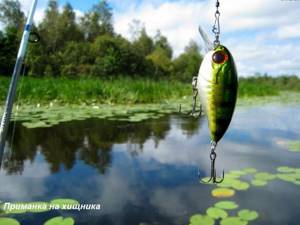
In an arsenal designed for pike fishing, there must be suspender baits that have neutral buoyancy. During wiring, you need to take pauses when the bait hangs in the water column. This technique perfectly provokes pike to bite.
Perch loves red. Therefore, to catch it, it is preferable to choose baits that are colored accordingly.
Fishing for pike and perch may seem simple at first glance, but in fact there are many nuances to it. To achieve success, the first thing you need to do is choose the right spinning rod. With high-quality gear, fishing will be comfortable, and the chances of ending up with a good catch will be maximum.
Poppers

Popper is one of the eccentric varieties of surface modification of a wobbler. Designed for guiding along the surface of the water in overgrown water areas of reservoirs, the so-called toad beds and inconveniences. A popper, unlike a classic wobbler, does not have a blade, and the working element is a cut on the front end surface of the simulator. When jerking, the wobbler creates squelching sounds, splashing water along its trajectory, which attracts an active predator, waiting in ambush for a victim convenient to attack.
Poppers vary in size, usually having the same structure in the form of a cylindrical object, sometimes tapering into a cone at its end. The popper is equipped with one or two tees, painted in various colors. Typically, the prey of a spinning angler when using a wobbler is pike.
Surface baits and white fish.
Looking at the huge number of baits in my boxes intended for catching chub and ide, I never cease to be amazed. On the one hand, I understand how omnivorous this fish is. On the other hand, to what extent chub and ide can be selective and capricious. How else can we explain so many baits designed to catch only these two types of fish. And if you add asp and rudd to this list, the number of baits will increase noticeably. Today we will talk about boat fishing for white fish in deep water using bulk surface and near-surface baits. It is no coincidence that I focused on a large number of chub baits. Since, when going to the Volga to purposefully catch this fish, we never know which specific class of bait the chub will prefer today.
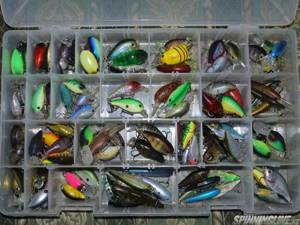
It is not enough to correctly determine the fishing location itself; it is often necessary to select the right bait; it is equally important to present it correctly, select the desired fishing horizon, and so on. It is not uncommon for surface baits to help achieve results; fishing with them is not only effective, but also spectacular. As a rule, bites occur right before our eyes; when attacking such baits, the fish often flies out of the water and shows itself; the level of adrenaline in the fisherman’s blood at this time simply goes off scale. Poppers. Perhaps this is one of the most common surface baits in our country for catching perch, but for some reason it is underestimated in catching white predators. Each popper, like any other spinning bait, is individual. There are many options for serving a popper, the most correct one for us is the one that brought a bite and fish. But, before this happens, we have to work hard, using different variations of wiring and changing the location of our floating device. In the same way, when experimenting with wiring, we have to look for the one that will interest the object of our fishing. And the correct choice of place to anchor the boat is often no less important than the correct wiring. It’s not bad to catch chub or asp on the rifts or steep rivers at the bend of the river. It should be noted that the presence of a boat in such places is not only mandatory, but necessary, since in most cases, throwing a bulky bait from the shore to promising places in deep water is very problematic, and sometimes simply impossible. But when fishing from a boat, we can catch this fish with a popper in different ways of presenting bait. For example, casting bait strictly downstream followed by retrieving it upstream. Or with casting the bait across the current with different variations, a little higher or a little lower downstream. In any case, the wiring turns out to be demolished. The second option is especially effective when the popper goes around some kind of underwater obstacle along an arcuate path, for example, in the form of an underwater island. Often the attack of a chub or asp occurs not at the moment of acceleration of the bait, but at the moment of a pause.

And in the case when the fish is not active, it is more advisable to reduce not only the speed of the retrieve as much as possible, but also to reduce the number of jerks between pauses, for example, from two or three to one. It turns out something like this: a popper jerk makes a gurgle, then a pause of two to three seconds, then a jerk again - a pause and so on, I do this until the bait is in a promising place. In this way, there is no need to bring the bait to the boat, since the chub and asp are quite shy and careful. It is unlikely that they will accompany the bait all the way to the boat, unlike the cases when we catch pike perch with a jig or pike with deep-sea wobblers. There, yes, bites often happen right under the boat. But there, we must take into account the depths in the fishing places are completely different, an order of magnitude deeper. Still no less interesting places for using poppers are under islands, when the current hits the island and, moving away from it, forms a rip current. Sometimes it works for me to move the bait directly along this stream, but in most cases I still try to place the popper nearby, in places where there is a return or small lulls.
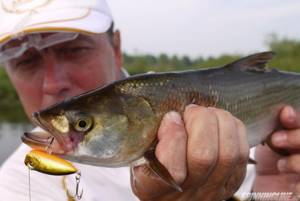
Chub and asp are not all the white fish that I managed to catch with a popper. The ide does not disdain this bait either. True, unlike chub and asp, ide is more attached to areas where there is shallow water overgrown with grass next to the stream. By moving the popper along the grass, the ide often attacks the bait. This fish is especially active in the evening dawns. At this time, the ide comes out to feed and you can often observe how it shows itself in the grass or next to it with powerful splashes. Everything we talked about regarding the placement of the popper came down to the mandatory animation of the bait, that is, in all cases we have to give the popper a certain game. But there are times when, when fishing with this bait, our intervention in the wiring is practically not required, I would say it even turns out to be harmful. By mid-summer, the water area of the Cheboksary Reservoir is already full of places overgrown with aquatic plants. In such places you can often find schooling rudd. Especially if these are places overgrown with water lilies and where there is a current nearby.
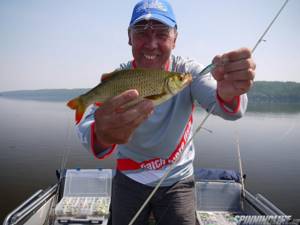
Swimming onto the boats next to the water lilies, we can see how these fish swim across the surface and show their backs. Occasionally scattering in different directions from the predator hunting for her. This is exactly the case when no effort is required from us in wiring the popper. I throw the bait as close as possible to the school or into the school itself, rudd, and wait. At this time, the popper is in a free drift and slowly floats with the flow. Unlike the chub or asp, the rudd does not hit the bait hard and does not fly out of the water at this time. The rudd bite is much more delicate. It is very interesting to watch how our bait, after a bite, becomes like a real float. First, the popper moves from a horizontal position to a vertical position, and then dives under the water. And this is how most of the bites happen. In most cases, the rudd is caught at the rear tee of the bait, which has feathers, so I would venture to suggest that it is the tee with feathers that attracts and tempts the fish to bite.
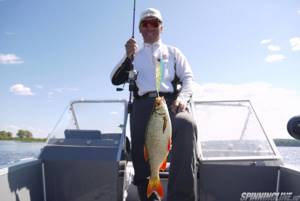
Walkers. Unlike the popper, this bait has some advantages. In particular, any walker comparable in size and weight to a popper, due to the lack of feathers on the rear tee and slightly different geometry, flies much further, and this, as you understand, is not a bad argument when catching white fish. The wiring of this bait, although not significantly, differs from the popper; firstly, the walker does not gurgle, at least most of the walkers. Secondly, as a rule, his game is based on a clearly scouring line from side to side. And by changing the strength and frequency of jerks, we can present this bait in different ways, in particular, change the degree of deviation from the axis in different directions, from fairly large zigzag tacks, to almost straight lines without the bait deflecting the wiring. Well, another not big, but still noticeable difference is that it is much easier to control a walker in a strong current than a popper. In my practice, I have repeatedly succeeded in catching chub and asp immediately after splashing down the bait.
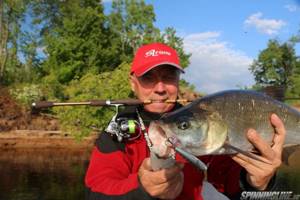
In cases where after splashdown the bite did not occur, then in most cases I let the bait lie motionless on the surface, and when everything calms down, I start retrieving. The wiring itself, as I already said, can vary in speed and frequency of jerks. If fishing takes place in a limited area, for example, between the branches of trees that have fallen into the water after a flood, and chub and asp love such places, then I make several jerks and again let the bait lie motionless, and repeat this several times until the walker leaves the promising place. The walker can also be used in quiet areas under the islands next to the stream. And although the chub is a follower of the current, it is often possible to catch it in such lulls.

The length of the wiring, as a rule, does not exceed one meter, then the walker hits a strong current and is quickly carried away by the current from this promising place. Previously, for some reason, I thought that using a walker was advisable only in calm weather, when there were no waves on the reservoir. The practice of recent years shows that when catching asp, this condition is not at all necessary.
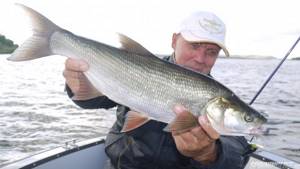

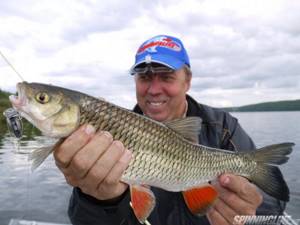
The places where these wobblers are used in relation to ide are the same overgrown shallow waters as in the case of poppers. If the fishing areas have windows free of grass or there are several centimeters of clean water above the grass, such places will be ideal for catching not only ide, but also rudd.
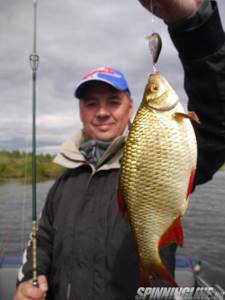
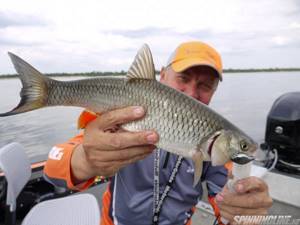
It doesn’t matter which of the designated places I choose for chub fishing. The main thing is to place the boat at the maximum distance from the shore, but to reach the water's edge. Otherwise, the closer to the shore our boat is fixed, the greater the chance of spooking the fish. The fishing itself for chub differs from ide; or rather, the method of presenting the bait differs. Here there is no wiring as such, that is, it resembles catching rudd with a popper. After casting the bait, I do not retrieval, but leave the wobbler floating freely, or rather, it drifts with the current, usually along the shore. Surprisingly, the chub in most cases attacks a wobbler lying motionless on the surface. Fishing with surface baits has one interesting feature: we always see the fish attack, so often our nerves can’t stand it and we hook immediately after the bite. As a rule, our temperament plays against us; we simply do not allow the fish to swallow the bait, and we tear it out. The bite turns out to be empty. It’s hard for me to force myself not to hook in such cases, but only pause for a couple of seconds. After which I do a very small hook. The fish, in this case, already “sits” on the hooks of our bait. It should be noted that I often catch chub in conditions of limited visibility, that is, at dawn, when the pond begins to get dark. And here the color of the bait plays an important role. This does not mean the influence of the color of the wobbler on the fish’s bite, but its visibility by the fisherman in conditions of limited visibility; these are mainly wobblers of yellowish lemon colors.
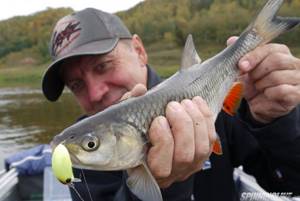
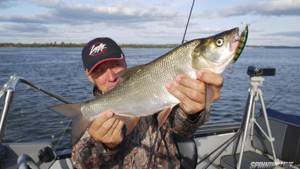
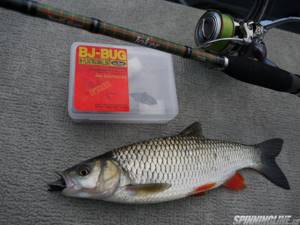
And the chub really appreciated these insects. Especially when fishing on the rifts. There is no need for long casts; we send the bait downstream as far as possible, and then, as in the case of wobblers, we simply float it downstream. At the same time, we try to control all stages of this drift. Since in most cases bites occur precisely during rafting. And only when the bait sent downstream turns out to be unclaimed can you start wiring; I note that the BJ-Bug does not have any game of its own. During the retrieve, we reel in the beetle as slowly as possible with pauses, and occasionally twitch it with weak movements of the rod. It is this behavior of the insect on the water that provokes chubs and ides to bite.
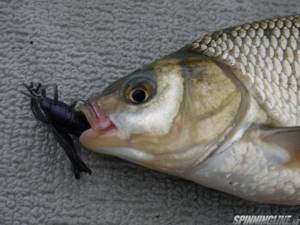
I have noticed more than once that if you only slightly increase the speed of the retrieve, the bait becomes uninteresting to the chub. Of course, I am not saying that surface baits always and everywhere show excellent results without alternative. Often they simply expand our capabilities and are an excellent addition to baits of other classes. Be that as it may, these baits have shown their worth in practice and now they deservedly take up space in my boxes.
Rattlins
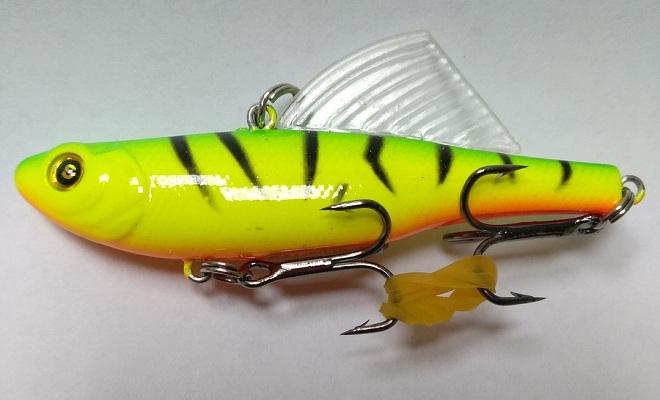
Rattlin is also a type of simulator from the family of wobblers without blades. These types of spinning baits are balanced by introducing a certain weight into the body of the wobbler, which stabilizes the stroke and horizon of the retrieve, as well as the amplitude of movement of the rattle, while creating a noise effect. The flat body shape of rattlins gives off an extraordinary game that provokes fish to bite. This type of wobbler is considered a deep-sea bait; moreover, it is distinguished by a certain versatility of use for ice fishing with a winter spinning rod, where the target of fishing is pike perch. In open water, using rattlin, they focus on catching perch and pike.
Coil selection
For hunting pike and perch, spinning reels are more often used. Their main advantages:
- ease of use;
- the ability to throw light equipment over long distances;
- a wide selection of affordable models, from which every spinning player will choose the appropriate option for himself.
The size of the reel for pike fishing is selected in such a way that it harmoniously combines with the spinning rod. The spool must hold at least 130 meters of main line of the required diameter.
Multiplier reels are also used. These models:
- have high traction characteristics;
- are highly durable;
- do not twist the line during wiring;
- provide maximum sensitivity of the spinning rod.
Multiplier reels are suitable for catching large fish with large baits that create strong resistance when retrieving. They are often used to hunt trophy toothy predators.
Jerkbaits
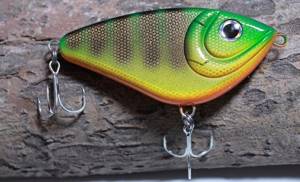
Continuing to consider the wobbler, let’s focus on a type of artificial bait called a jerkbait. A jerkbait is a large bladeless wobbler designed for sharp jerking retrieves. In appearance, jerkbaits imitate natural fish, being flat and tapering towards the tail. Like other wobblers, they have three degrees of buoyancy, and therefore, the practical use of a jerkbait can be selected for any fishing horizon. Most often, jerks are painted in natural fish colors of black and white with silver tints interspersed with bright attack points. Jerkbait is one of the types of spinning bait designed for specialized hunting for trophy pike.
Spinning rod structure
Three types of spinning rods are used for fishing for pike and perch:
- medium-fast action;
- fast formation;
- super-fast build.
The latter are characterized by maximum rigidity. They allow precise twitching of wobblers and provide the best sensitivity when fishing with jigs. Spinning rods of medium-fast action, in turn, due to their softness, tie up the fish, absorbing its jerks and preventing it from getting off the hook. They are well suited for hunting perch - this fish has weak lips that can tear when fishing.
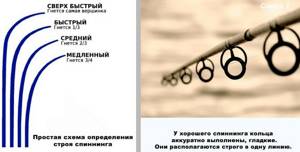
Medium-fast spinning rods are used mainly for fishing that requires uniform retrieval. Fast action rods are a kind of golden mean. Such spinning rods are extremely versatile.
Foam rubber fish
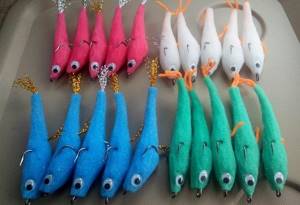
Among soft baits for spinning, foam fish stand out. This is a purely our, domestic invention, which has worked quite successfully in pike perch fishing, and is already recognized by the world fishing community as an effective and efficient tool. The imitation is made of dense foam rubber in the shape of a fry or carrot and painted in a promising color. Sometimes foam rubber is impregnated with an attractant, making an edible version of foam rubber like a silicone nozzle. The simulator requires mandatory shipment, most often of which are stationary jig heads of various weights and sizes.
Important! Foam rubber does not have its own game and requires forced animation, regardless of the wiring conditions.
It is the sharp twitching game that attracts the pike perch, which senses vibrations from movement and the sound of the weight hitting the bottom of the reservoir.
Varieties
Recently, many varieties of artificial baits have been invented. Each has its own design features and performance characteristics. Some are considered generalists, while others are highly specialized.
The main types of spinning baits are:
- spinners;
- wobblers;
- silicone
The listed spinning lures are divided into categories, types and groups. Their choice directly depends on the fishing conditions and the predator that is planned to be hunted.
Spoons
Spoons are perhaps the most ancient artificial baits, which appeared several centuries ago. Fishermen have long noticed that the predator reacts to a “piece of iron” held at a given speed directly in front of its ambush site.
Today, fishing companies have developed a huge number of different spinners that can catch predators. They all fall into two broad categories:
- rotating;
- fluctuating.
Both categories of artificial baits for fishing have their own characteristics. Let's look at them below.
Turntables
The spinner is the most famous artificial bait for fishing. All beginners begin their acquaintance with spinning with it. This can be explained simply: it is enough to throw it into the water and slowly move it through the water column. Such simple fishing allows you to catch the first predator in your life and experience the delights of its fishing.
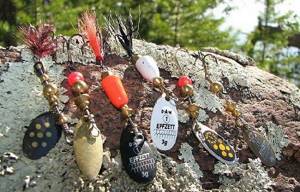
Back-loaded spinners are a good bait for catching perch and white predator
Almost any fish can be caught using rotating spoons. In addition to the predatory perch, pike, asp, pike perch, and catfish, you can catch chub, ide, rudd, and dace with this bait. There are even peaceful roach, bleak and crucian carp. The pinwheel is loved by trout and other representatives of salmonids. On northern rivers it is readily attacked by grayling, lenok, whitefish and others.
Spinners are divided into two types:
- rear-loaded;
- front-loaded.
For the former, the load is located on the axis of the bait below the rotating petal. The latter have a load that is carried forward of the body.
Fishing lures
Back-loaded spinners are the best universal baits for a beginning spinning angler. They have the following advantages:
- work in currents and in still water;
- simple uniform wiring is sufficient for them;
- caught at any time of the year;
- Suitable for all predatory, semi-predatory and some peaceful fish.
Among the variety of rear-loaded turntables, products from the French company Mepps, the Swedish Myran and the American Blue Fox are especially loved and popular. These lures are a must-have in the arsenal of every spinning angler who wants to consistently fish in different conditions.
Advice! One of the most versatile turntables is the Mepps Black Fury model with blade No. 2.
Front-loaded spinners have found application in jig fishing. They are more often used in spring and autumn in areas with a clean bottom - channel dumps, riffles, in pits and whirlpools. These are effective baits for hunting pike perch, pike, commercial perch and catfish.
The most famous jig spinners are Master spinners. They are available in several modifications, have different sizes and weights. However, experienced spinners make them with their own hands:
- petals are cut out of non-ferrous metal;
- Cheburashkas are used as cargo;
- the spinner axis is made of steel wire;
- the tee is equipped with a goat hair edging and is rigidly fixed using a heat-shrinkable tube.
Such homemade baits are low cost, easy to make, and catch predators well.
One of the options for a front-loaded spinner is a tail spinner. What distinguishes it from the classic pinwheel is that the petal is placed below the hook. This bait works better and more consistently in free fall and is capable of influencing a passive, apathetic predator.
Oscillators
Oscillating spoons are the oldest artificial baits invented by anglers. They have not lost their relevance to this day and in skillful hands they are a formidable weapon for catching pike, pike perch, heavy perch, catfish, asp and other predators that inhabit the waters of our country.
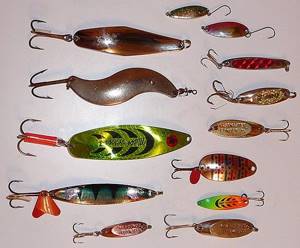
Oscillating spoons are available in different sizes and shapes
Essentially, a vibrator is a piece of metal that has a certain shape, bend, size and weight. These parameters characterize the purpose and operating properties of a particular model:
- wide-bodied spoons with a slight bend are designed for shallow or still water;
- narrow-bodied curved models are used at depths or currents;
- spinners with average dimensions work at different depths, moderate or weak currents.
The main object of hunting for oscillating spoons is pike. The spotted beast loves this bait, which is why every experienced spinning fisher has it in his arsenal. Good vibrators were made during the Soviet era, they are still being produced, and there are also many Finnish, American and other European products that deserve attention.
Lately, fishing with micro-spinners has been gaining popularity. This is a separate direction of ultralight, which appeared in Japan and was originally used for trout hunting. Gradually, these baits fell in love with domestic fishermen, and are now used for fishing chub, ide, rudd, perch, dace, grayling and whitefish.
Oscillating spoons include jigs. This is the best asp bait that has ever been invented by anglers. Differs in the following features:
- phenomenal range;
- stable play on fast retrieve;
- confidently stays in the upper horizon.
The ranking of the most catchy jigs is headed by the famous Kastmaster. The best also include Hopkins and Trekhranka. Experienced spinning players will certainly have other models in their kit, but for beginners, the three listed above will be enough at first.
Advice! Wide-bodied, non-snagging spoons weighing up to 15 grams are the best baits for pike hunting in toad fields.
For fishing among aquatic vegetation and in snags, non-snacking oscillating spoons are used. Their hooks have wire protection, which allows them to be held in strong places, bypassing hooks. There are models with rigidly soldered singles or doubles and lures with freely suspended tees.
Mandula
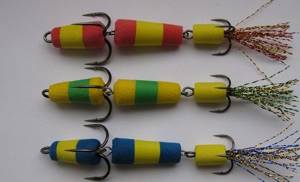
Mandula is a composite bait made of certain parts, often combined with a cylindrical and cone-shaped form. These spinning baits are assembled on articulated, separate metal rods made of foam or foam parts. The mandula usually has three or four independent links. In the center the links are cylindrical in shape, and at the edges they have cone-shaped modifications. The coloring of the segments of the nozzle varies, alternating dark and light tones.
With uniform wiring, each link moves along different amplitudes, ultimately giving the effect of moving like a snake, which arouses interest in the fish. The mandula needs baits, which can be picked up both at the bottom and at the very surface of the water. The bait specializes in fishing for pike and perch, as well as pike perch.
Where to catch pike or perch using a spinning rod
To choose a spinning rod suitable for catching pike and perch, it is important to take into account the conditions in which you will be fishing and the expected size of the trophies. These predators are found in lakes, reservoirs and rivers. In the coastal zone, at depths of up to 3-4 m, predominantly small fish are found. For fishing in such places, light baits and spinning rods are used, which allow you to work with them comfortably. To look for perch and pike in the coastal zone you need to:
- in the bays;
- in thickets of grass and at their borders;
- in snags;
- on the edges;
- at the confluence of streams.
Large fish prefer to stay in the depths away from the shore. To fish here, you will need bait weighing up to 50 g and appropriate spinning rods. Suitable places for fishing would be:
- eyebrows;
- pits;
- underwater streamers;
- navels - rounded elevations at the bottom;
- snags.
The toothy predator is also often found in small ponds that become heavily overgrown in the summer - toad ponds. The main thing is to know how to fish in such conditions. It is necessary to use non-meshing installations and short wiring through free areas of water.
Spinnerbaits

A spinnerbait is a combined fishing tool that contains silicone and metal parts of baits assembled on one bracket. Spinnerbaits are classified as non-hook baits, since their main purpose is to catch predators such as pike in heavily overgrown reservoirs. An elastic metal wire frame or bracket, bent at a 75-degree angle, on the top of the rocker has one or a pair of metal petals, akin to the petal of a spinner.
The second arm of the rocker is tightly connected to a kind of stationary jig head, sometimes made in the form of a miniature fish, the hook of which is covered with a strand of silicone hair. Silicone strands prevent snags and, together with the flash petal rotating at the top, lure fish out of ambush. Due to the unique design, spinnerbaits have received a certain specific application; of course, catfish are not the target of hunting with this kind of simulator, but perch and pike on the borders of thicket banks are quite a frequent trophy.
Fishing. Information portal "LANDFISH"
Until recently, our fishermen treated surface baits as exotic, used abroad for catching bass and other “overseas” fish. However, in recent years it has become clear that all these poppers, walkers, gliders, and torpedoes are excellent for catching our fish - pike, perch, and other predators. Moreover, in certain conditions they are simply irreplaceable.
All the secrets of fishing with surface bait are told in an article on our website
In general, fishing with surface baits has found its niche in spinning fishing, and the baits used for it are in the angler’s arsenal.
Why are surface baits needed?
Each of us watched in the summer as the fry fanned out from the predator. The fact is that the predator preys on small fish feeding at the surface of the water among water lilies, near thickets of sedge and other aquatic plants.
Why don't we throw our bait under his nose? This is what surface baits are for. Unlike other spinning lures, we have the opportunity to observe them during the fishing process. And it’s quite difficult to lose them when hooked - they will float up and you can get them from the boat, or by going into the water. True, if your bait is torn off by some kind of “crocodile”, then it is almost impossible to do this.
Thus, if a predator is hunting small fish near the surface, fishing with surface baits will be most successful.
Where and when?
These baits can be used most effectively from May to late autumn. The best way to use them is:
- When fishing in thickets in shallow water.
- In swampy reservoirs and peat quarries.
- In places where a predator actively attacks fry in open water and among algae (perch boilers, for example).
- In the absence of wind and noticeable roughness on the water.
What will we use to go after the predator?
The rod should be:
- Lightweight, since when wiring you will have to work mainly only with a brush.
- The action of the rod is extremely fast or, in extreme cases, semi-parabolic. A rigid spinning rod allows you to accurately cast the bait. After all, you often have to fish in windows of aquatic vegetation. And such a spinning rod transfers all the movements of the bait to the hand very well.
- Material – carbon fiber.
- The length of the rod should be between 1.98 - 2.4 m. If long casting is required, you can use a spinning rod up to 3.3 m long. But the test rod should not exceed 21 g. Surface lures, as a rule, weigh less than 17 g. A small margin of safety will be required to guide the gear through the thickets. And you will have to work in the bushes almost constantly. Need to be taken into account. That a long rod, when retrieving it and imparting oscillatory movements to the bait, itself oscillates with its own frequency and amplitude. These vibrations are superimposed on the vibrations of the bait. The controllability of the tackle deteriorates.
- Proper balance of the rod . Its center of gravity when the coil is installed should be approximately 2-5 cm in front of the coil. This will allow you to grasp the rod with your hand in the center of gravity and control it without resting on your elbow. The game of bait in this case will be very varied. But surface baits are intended to be played with. They themselves cannot play (except for those equipped with special propellers and other devices).
What fishing line should I use?
When fishing for perch, given that it has weaker lips than pike, monofilament fishing line is preferable. With super fast hard spinning, the braid used will lead to lip rupture and loss of fish.
When using monofilament fishing line, due to its stretchability, this will not happen. Therefore, if you have a fast rod, use a monofilament rod. If semi-parabolic - braided. These restrictions do not apply to pike. You can also use a cord with a rigid rod.
About the reel
A surface fishing reel must meet the following requirements:
- It is desirable that it has an endless screw , allowing the line to be laid crosswise. Since during this kind of fishing we constantly jerk the line, the tension when laying it is not constant. A “beard” may form. But in a coil with an endless screw this is eliminated. True, there are reels that perfectly lay the line without this device.
- The reel must have an instant stop .
- The line guide bracket must be well secured.
- The fishing line or braid should be wound flush with the side of the spool . When using monofilament, you can go a little lower. To completely fill the bobbin, winding with various materials (thread, electrical tape, etc.) is used.
- The gear ratio of the coil must be at least 5.
- The reel must be designed to wind 100 m of fishing line with a diameter of 0.22 mm . Braid is used from 4 to 15 lb. A larger diameter is not required for this fishing.
How to set up a friction brake
To effectively dampen the jerking of fish when fishing, be sure to set up the friction brake correctly. You can do this “by eye”. You can, by reading on the packaging the force required to break the fishing line, set half the force using a steelyard. But these options do not take into account the friction of the fishing line in the guide rings. Therefore, it is better to hook the bait on the shore to some obstacle and raise the spinning rod to a vertical position. The friction clutch must hold this load.
Types of surface baits Popper
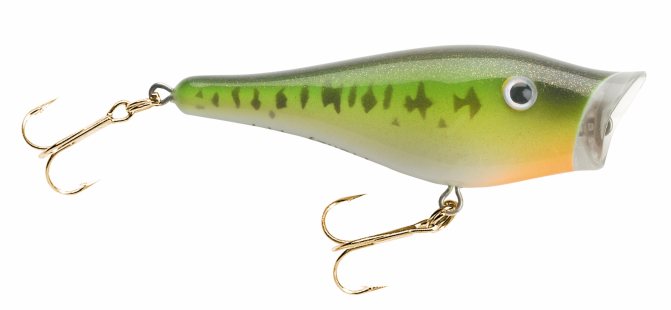
A popper is a bait that, when twitching the tackle, makes a jerk on the surface of the water, accompanied by gurgling. Actually, the ror is in English and the zone is something like “bul-bul.” The stronger this sound, the more effective the bait is.
The characteristic features of the popper are the presence of a fly (Lurex, a bunch of threads, feathers) on the rear tee and a “spitter” in the head part. A “spitter” is a cutout in the conventional head of the bait at an obtuse angle or semi-oval shape.
When at rest, the popper should float near the surface (or in the water column), with its nose raised. When it jerks, it jumps out of the water and creates a characteristic sound.
Poppers come in floating, sinking and suspending types. The predator takes a sinking bait more confidently, since in the water he sees the bait in a three-dimensional image. And this makes it possible to aim more accurately.
Sinking poppers fly far. And on an unfamiliar body of water, with their help you can quickly locate the fish. Sinking poppers require a faster retrieve than floating poppers. After all, these baits are used most often in places where algae grow.
Bringing the popper to mind
Sometimes it is necessary to give the bait a yawing character. In this case, the front sight is removed from the tail tee and the tee itself is loaded (for example, with solder). In this case, the bait will raise its nose even more and will move, yawing left and right.
In order for the popper to become “long-range”, its tees can be loaded with pellets.
If it is necessary to protect it from snagging, the hooks can be equipped with wire protection.
And if you want to guide the bait along a complex trajectory, just pull the rod in the direction you need. The bait will move in the same direction.
Torpedo

A special feature of the torpedo is the presence of a propeller in the rear part of the bait (there can be two propellers - in the head and in the tail of the bait). The front sight can also be installed not only on the rear tee.
When at rest, a torpedo floats parallel to the surface of the water. When on a leash, it is led evenly. Fish are attracted by the noise of working propellers.
The movement of the bait in the water is not yawing, but linear. There are fewer empty bites with this bait than with a popper. When guiding a torpedo, a lot of resistance is created. Torpedoes “spit” no worse than poppers.
There are combined baits that have both a “spitter” and a propeller. In a calm state, they should also float with their nose to the top at 45 degrees.
An important feature of these baits is that they are easy to make yourself. This can be done from a tree knot (for example, linden). You can use old or poorly made wobblers by cutting off the nose with the blade and gluing a “spitter”. This suggests that the wiring, simulating a fish running away from a predator, is simple and, obviously, quite chaotic. That is, the fry runs away according to the principle “save yourself as best you can” - without any rules.
And if you remember, the Finn Rapala, when making the first wobblers, made poppers from pine chips. And the fishing technique was born after tying a fishing line to the oar handle of a moving boat.
Lure color
The color of the bait is of great importance. And not so much for the fish, but for the fisherman. If your bait is painted in light colors, then it is much easier to control visually, which is highly desirable. It is certainly more difficult to see a dark bait in the wild. Although fish (for example, perch), more often bite on bright bait (red, yellow, or a combination of both).
Lure size
It has been noticed that when catching perch it is better to use small baits (about 3 cm). The smaller the size, the more often the perch bites. When fishing for pike, much larger baits are used. Well, according to Senka and the hat!
Hydroplane
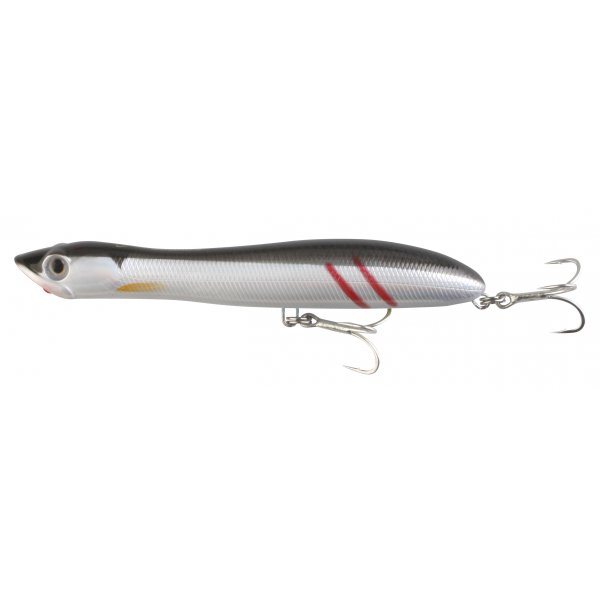
As you know, pike is not a schooling fish and hunts from ambush. She sets up her ambush among snags, algae and other obstacles at the bottom of the river. Any bait that ends up in such places can get caught on these obstacles (if it is not “unhooked”) and be lost.
With surface baits the situation is somewhat easier, but they can also be lost due to a snag. And all this is due to the fact that the tees on them are located at the bottom of the bait and cling to the algae when the distance from them to the surface is only a few centimeters. In addition, at the moment of splashdown, any bait is first buried by inertia. This is where the hook occurs.
To avoid such troubles, a glider was invented. It is a bait shaped like the bow of a motor boat. It is pointed at the front. The hook used is a single, large one, with the tip pointing towards the top. In this case, the bait does not cling to obstacles located below the surface of the water. And for that. So that the bait is always positioned with the hook pointing towards the top. Its lower part is loaded with a lead plate. The body of the bait can be made of hard foam.
And even immediately after splashdown, the glider immediately turns upside down. It is best, however, to throw it into a place where the algae are not very close to the surface (in the window between the algae). And the movement begins after the bait is turned over.
How does a glider work?
From the name of the bait it follows that when retrieving it, it should go on planing like a motor boat. This is what happens when the tackle twitches. When it moves, a wave is created on the surface of the water. The sound (“spitting”) is no worse than that of a popper. The only drawback, if you can call it a drawback, is that small fish do not take this bait. Shchuryat and perch can be caught with it, weighing from 600 g. But it is very convenient for exploring an unfamiliar body of water.
By the way, to completely guarantee non-snaking, you can protect the hook with wire.
Walker or stickbait
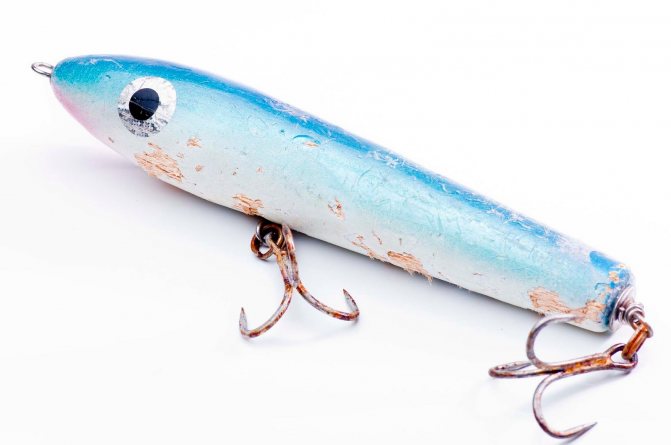
A bait that differs from a torpedo by the absence of a propeller and a loaded rear tee. The loaded threesome allows her to prowl during the retrieve. In the water, in a calm state, it is located with its nose raised to the surface. The work of the bait is no different from the work of the popper.
Croatian egg
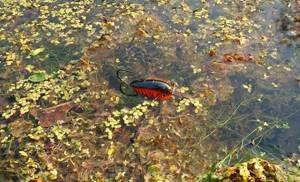
The Croatian egg is one of the representatives of such an orientation of simulators as a glider. This is a purely superficial bait, similar to a popper, which is a type of non-hooking bait. The main body of the Croatian egg is made of wood or plastic with positive buoyancy qualities. The end part of the egg sometimes has a flat or concave cut inside the nozzle, through which a glider passed along the surface creates a wave and noise effect that is of interest to the predator.
The body of the egg is balanced in such a way that a single hook built into the back of the simulator is constantly directed with its sting upward, protruding from the water above the surface of the reservoir. This feature allows the Croatian egg to freely pass through any water thickets. The target of the Croatian egg hunt is summer pike, which inhabit river backwaters, lakes and ponds overgrown with surface aquatic vegetation.
When to catch
Pike and perch remain active all year round.
Spring
At the beginning of spring, after rivers and lakes are free of ice, when the water is still cold, you need to look for fish at depth. As summer approaches, pike and perch increasingly come out to feed in shallow waters warmed by the sun. By the end of spring, these predators gradually switch to summer mode.

Summer
In summer, small pike and perch feed under the shore, and large specimens hunt at depth on edges and holes, as well as in snags.
Winter
In winter, you can successfully catch pike and perch in bodies of water that are not covered with ice. You need to look for fish at depth and use slow retrieves, which allow you to tempt a predator that is passive in cold water to bite.
Autumn
At the beginning of autumn, pike and perch hunt both near the shore and at a distance from it. As freeze-up approaches, they gradually go deeper. In the second half of autumn, the predator begins to actively feed in order to gain fat for the winter - this is the best time for catching pike and perch.
Zywiec
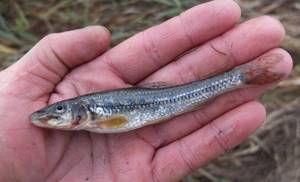
For some types of rig formation in spinning fishing, fishing using live bait is successfully used. Of course, it is more correct to say that the fish used will already be dead, placed on hooks and loaded according to the fishing conditions. Many predators, including asp and pike perch, readily respond to fishing using bleak and dace as bait. Pike is caught by placing crucian carp and roach in spinning rigs. The catfish gets caught on the retrieve with the installation of loaches, eels and frogs.
The use of natural food objects attracts predators not only by the style of fishing performed by the fisherman, but also by the presence of strong odors emitted by the live bait used for fishing, which does not arouse absolutely any suspicion in the actively hunting fish of a catch when catching an easily accessible prey. The rig for live bait is assembled by combining leashes and hooks of various modifications and sizes, as well as fastening rubber bands.
If it is necessary to carry live bait in a certain water level and supply it over long distances, the rigs are loaded with weights, arranging spaced rigs. Positive hunting results can be achieved by using not only whole fish, but also fresh pieces of chopped meat or fillet, as well as offal, which stimulate the fish’s sense of smell and appetite. Often, when the bite is depressed, it is the transition to the live bait version of the spinning rig that allows you to get the long-awaited, but well-deserved success with perseverance.
The best lures for spinning
Rublex Orkla
Rating: 5.0
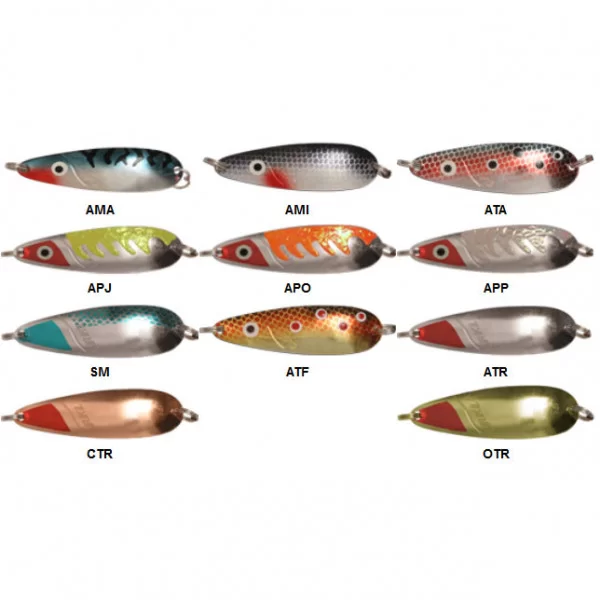
The famous series of oscillating spinners, which have become the hallmark of the Rublex company. It uses the same principles of geometry as domestic spinners of the Atom series - the body has a double bend, allowing the bait to make dynamic, jerky movements, similar to the yaw of a small fish.
According to the manufacturer, the Rublex Orkla series has ten different color options. Some color schemes are so realistic that the lures take on the appearance of trout and mackerel fry. There is another option, in which the emphasis is on catchiness, achieved thanks to the red color of the head part. The cost of baits in this series is low, and they can be used everywhere, be it a lake, a river or the open sea.
Advantages
- low price coupled with high catchability;
- the ability to choose among ten color options;
- unique spasmodic movements that highly accurately imitate the yaw of fry.
Flaws
- not detected.
"Atom" and "Atom-2"
Rating: 4.9
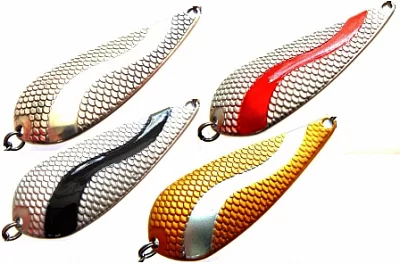
An oscillating spoon for spinning is widely known in the circles of domestic fishermen, the prototype of which was a homemade stamping from sheet metal. The first version of the "Atom" had a characteristically elongated body shape, doubly curved around its entire perimeter. This geometry allowed the spoon not only to show a unique game when changing the wiring, but also to produce a characteristic low-frequency sound that attracted predators from afar. With the change of generations, there was a slight shift towards modernization; Atom-2 acquired a shortened body, taking on a teardrop shape and a small plastic blade on the three-piece.
Since the first Atom models were produced back in the Soviet Union, the behavior of the spoon on the water has long been successfully studied by everyone who is not indifferent to fishing. Both small river representatives and real trophy specimens became his prey.
Advantages
- wide variability of design;
- the possibility of catching trophy predators;
- low cost compared to competitors;
- predictable behavior of the bait when making a retrieve.
Flaws
- not detected.
Fishing with surface baits
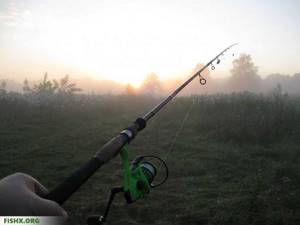
For fishing with surface baits, a shortened special spinning rod with a fast action is required, since you have to fish in the grass, and snags are still inevitable in it. Often you just have to “rip out” the bait from the thickets of water lilies. An example of a not very long universal spinning rod with a fast action is the Chokai series rod from Surf Master with a test of 7-28. Spinning rod length – 2.75 m. Weight – 220 grams. The characteristics of the rod are intended for fishing “through the grass”. The placement of rings according to a special system also serves to strengthen the rod.
Share with your friends!
